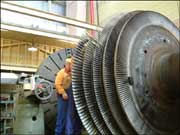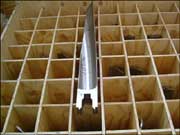8. Steam Turbines



The Science of Steam Turbines
The earliest use of a steam turbine in a power station was in 1888 in the North of England. It is believed that Charles Parsons sketched the original design of this turbine on the back of an envelope. It took $300 000 of research and 25 years for engineers to improve its efficiency by just 2%, an indication of Parson's genius.
All of the turbine designs prior to Parsons' invention were inefficient, and he realised that this was because the steam was expanded in a single step.
|
Within Parsons' turbine each succeeding turbine blade was made larger. This enlargement was done in three ways by
- increasing the height of each blade
- increasing the diameter of the succeeding drums
- altering the angles and openings between the blades, twisted along their length and changed shape. Before that, they were constant profile.
Between each set of blades are diaphragms, these have blades that twist the opposite direction to the rotor blades. Steam expands and speeds up through the diaphragms then the turbine blades extract heat and work from the steam by slowing down the steam.
These principles are still part of modern steam turbine design.
Heat to Kinetic Energy
This energy conversion occurs in the turbines of the Wairakei power station. Each of the 11 turbines is
- made up of a central shaft with blades around the outside
- made efficient by careful design of the blade shape to capture the energy of the expanding steam
- designed to operate with a specific pressure of steam
- designed to spin at a precise speed.

